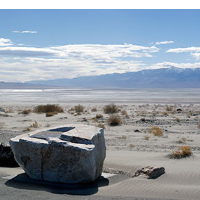Judge Won’t Let Los Angeles End Its Owens Lake Restoration
 Owens Lake
Owens Lake
The area surrounding the Owens Dry Lake may, indeed, be a “naturally dusty desert” as the Los Angeles Department of Water and Power (DWP) describes it, but that isn’t going to get L.A. off the hook from following court orders to expand its anti-dust efforts.
U.S. District Judge Anthony W. Ishii tossed out a lawsuit brought by DWP on behalf of L.A. that sought to avoid another $400 million in restoration work to the lake it famously sucked dry 100 years ago. The city has already spent $1.2 billion on mitigation measures to reduce the dangerous particulate pollution that blows off 40 square miles it has grudgingly accepted responsibility for.
But it sued to avoid paying more for three more square miles controlled by the Great Basin Unified Air Pollution Control District. The city argued that it had done enough to rectify its killing of the lake that once flourished across 100 square miles, and that Great Basin was responsible for that portion of the lake it now owns.
The judge disagreed. Who owned or managed the land beneath a pollution source isn’t nearly as important as who caused the pollution, he said. And that was not in dispute.
The origin of the fight between rural Owens Valley, 200 miles to the north, and Los Angeles was glorified in the 1974 movie “Chinatown,” a fictional account of the water diversion that began via aqueduct in 1913, and ended little more than a decade later when the lake went dry. Farmers were devastated and the area has been wracked by dust storms and drought ever since.
Judge Ishii said there was “no reason in law or logic” in the arguments made by DWP that L.A. lacked responsibility to carry on.
L.A. is not giving up. DWP spokesman Joe Ramallo told the Associated Press that the judge’s ruling was largely procedural and, “We remain committed to exploring all available means for stopping the enormous waste of California's scarce water supply and protecting consumers from the wasteful spending of Owens Valley regulators.”
L.A.’s mitigation measures include planting vegetation, laying gravel and flooding large areas of the lake bed with water. That last one is especially problematic in light of news Thursday that the Sierra Nevada snowpack, a key source of water for the state, was even more horrendous than earlier thought.
Frank Gehrke, chief surveyor for the state Department of Water Resources, said the snowpack is 17% of normal.
–Ken Broder
To Learn More:
Judge Axes Federal Suit over Lake (by Gillian Flaccus, Associated Press)
DWP Lawsuit over Owens Lake Dust Dismissed by Federal Judge (by Louis Sahagun, Los Angeles Times)
L.A. Sues to End the Century-Old Owens Lake Saga (by Ken Broder, AllGov California)
Bad News: Calif. Snowpack 17 Percent of Normal (by Tracie Cone and Rich Pedroncelli, Associated Press)
City of Los Angeles v. Great Basin Unified Air Pollution Control District, et al (U.S. District Court for the Eastern District of California)
- Top Stories
- Controversies
- Where is the Money Going?
- California and the Nation
- Appointments and Resignations
- Unusual News
- Latest News
- California Forbids U.S. Immigration Agents from Pretending to be Police
- California Lawmakers Urged to Strip “Self-Dealing” Tax Board of Its Duties
- Big Oil’s Grip on California
- Santa Cruz Police See Homeland Security Betrayal in Use of Gang Roundup as Cover for Immigration Raid
- Oil Companies Face Deadline to Stop Polluting California Groundwater





